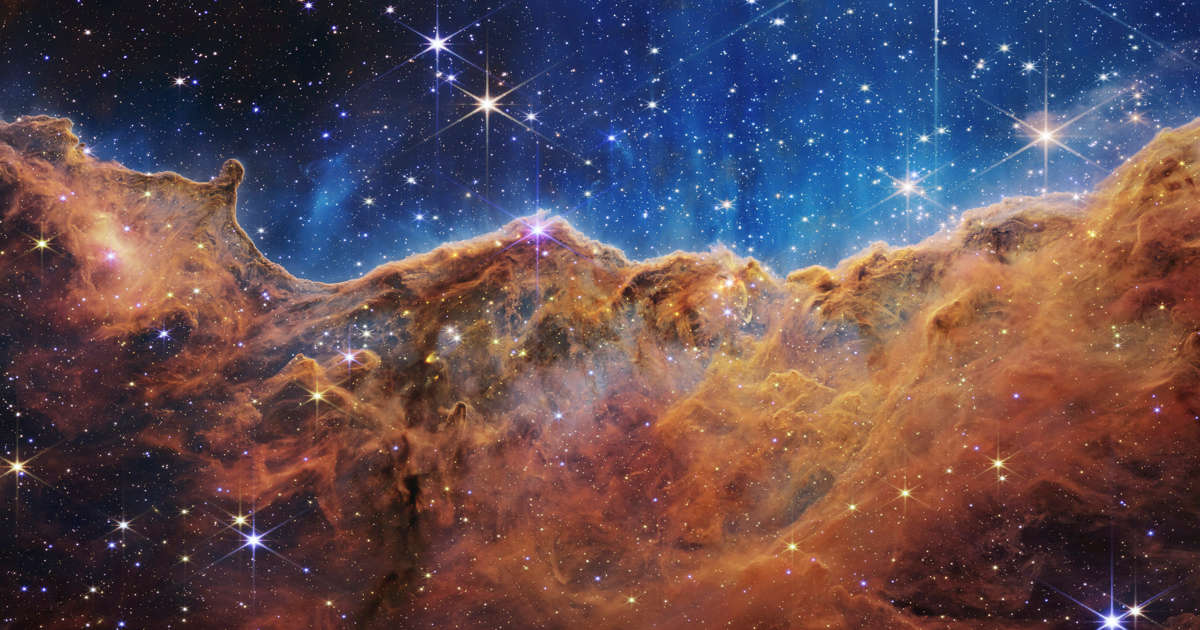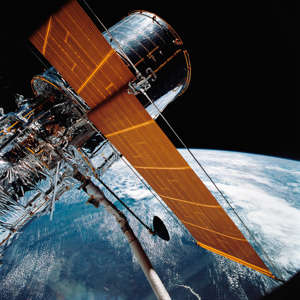[ad_1]
UP NEXT
The claim: Lack of stars in space photos means they were created with a green screen
© NASA, Getty Images
July 12, 2022: In this handout photo provided by NASA, a landscape of mountains and valleys speckled with glittering stars is actually the edge of a nearby, young, star-forming region called NGC 3324 in the Carina Nebula, on July 12, 2022 in space. Captured in infrared light by NASA’s new James Webb Space Telescope, this image reveals for the first time previously invisible areas of star birth.
Some proponents of flat Earth theory – the erroneous idea that Earth is flat instead of a globe – also say that space travel is impossible, sometimes claiming to expose inconsistencies in conventional narratives about space and space flight.
For instance, social media users have falsely claimed that propulsion would be impossible if space were a vacuum or that astronaut training regimes don’t match the purported conditions in space.
Start the day smarter. Get all the news you need in your inbox each morning.
A recent example involves a meme that claims pictures taken in space were created using green screens.
The meme shows four images. Three appear to be authentic lunar images from the Apollo missions. These show astronauts on the moon, with a dark, black sky in the background.
The final picture shows what appears to be an astronaut posing in front of a green wall while a person operates a camera.
“Not a single star in outer space,” reads the meme in a Dec. 6 Instagram post. (direct link, archive link) Haven’t you realized that it’s all just green screen technology. Time to wake up!”
The meme, which is captioned with hashtags such as #flatearth and #spaceisfake, garnered more than 500 likes in two weeks.
But the meme is wrong. Many photos of spacecraft or astronauts in space don’t show stars because the camera settings required to capture such brightly lit foreground objects are different than the settings required to capture distant and much dimmer stars, experts say.
USA TODAY reached out to the Instagram user who shared the post for comment.
Follow us on Facebook! Like our page to get updates throughout the day on our latest debunks
Stars too dim to show up in many space photos due to camera settings
The Apollo images in the meme were taken during daytime on the moon when sunlight is very bright, according to Noah Petro, a project scientist for the NASA Lunar Reconnaissance Orbiter.
This brightness creates a challenge for photographing stars from the lunar surface or even being able to see them with the naked eye. In fact, Apollo 11 astronaut Neil Armstrong reported he had to use optical devices to see the stars during the day.
Fact check roundup: Debunking the flawed science behind flat Earth claims
“If you’re just standing in your spacesuit on the surface of the moon and the sun is out … reflecting off of surrounding terrain, your spaceship, or your lunar lander, your crewmate’s suit, there’s so much extra light that it’s just not … dark enough for you to be able to see stars,” Petro told USA TODAY.
That said, it is possible to photograph stars from the lunar surface by optimizing the camera settings to capture dim objects.
“You need to basically change the camera settings … to let in a lot of very faint light for a long period of time,” he said.
This can be accomplished by adjusting the aperture, which controls the amount of light entering the camera, and the shutter speed, which controls the exposure – or amount of time light enters the camera, according to an article on lunar photography in Astronomy Magazine, which is affiliated with Discover Magazine.
Capturing dim, distant stars requires a larger aperture and a slower shutter speed to let in as much light as possible. But capturing brighter objects such as an astronaut, the lunar surface or a spacecraft requires the opposite.
“Generally speaking, the brighter the target object, the smaller the aperture and the faster the shutter; otherwise, too much light will hit the film, and the photo will be dominated by a washed-out, overexposed focal point,” reads the Astronomy Magazine article.
Thus, camera settings must be configured to support the goals of the photographer, David Melendrez, imagery integration lead for the NASA Orion Program, told USA TODAY.
“To properly expose … the spacecraft, Earth, moon, etc. – all of whom are much brighter than the distant stars – the shutter speed needs to be relatively short,” he said in an email. “With a short shutter speed, the stars simply do not register in the image.”
Photos from more modern missions, such as the recent NASA Orion spacecraft flight, don’t show stars for the same reason.
“The cameras on the Orion spacecraft were not designed for astrophotography,” Melendrez said. “They were designed and configured for engineering use: monitoring the performance of the spacecraft. To properly image the spacecraft’s external surface or even the Earth in the distance – both very bright objects – the dim stars in the distance could not be detected.”
Our rating: False
Based on our research, we rate FALSE the claim that the lack of stars in space photos means they were created with a green screen. Stars don’t show up in many space photos because they are too dim to be detected with the camera settings required to capture brighter objects.
Our fact-check sources:
- Noah Petro, Dec. 12, Interview with USA TODAY
- David Melendrez, Dec. 12, Email exchange with USA TODAY
- Astronomy Magazine, July 24, 2019, Why do pictures of Earth taken from the Moon show a black sky with no stars?
- Reuters, Dec. 7, Fact Check-Stars not routinely visible in photographs taken from spacecraft due to light exposure on Earth and Moon
- Wired, Nov. 13, 2007, Why Can’t Stars Be Seen In Moon, Space Photos?
- NASA Earth Observatory, Sept. 28, 2011, Where are the stars?
- NASA Jet Propulsion Laboratory photojournal, Nov. 7, 2008, PIA10508: Tethys in Eclipse
- NASA Jet Propulsion Laboratory photojournal, Jan. 7, 2005, PIA06168: Iapetus by Saturn Shine
- NASA Earth Observatory, July 28, 2011, Space Shuttle Atlantis streaked across the sky to its final landing at Kennedy Space Center
- Scientific American, March 27, 2020, Flat Earthers: What They Believe and Why
- The Planetary Society, Jan. 28, 2019, Why are there no stars in most space images?
- Royal Museums Greenwich, accessed Dec. 10, Moon landing conspiracy theories, debunked
- NASA Apollo 11 Lunar Surface Journal, Aug.12, 1969, Apollo 11 post flight press conference
- Space.com, Jan. 25, Can you see stars in light polluted skies?
- Royal Museums Greenwich, accessed Dec. 16, What makes the sky blue?
- NASA, accessed Dec. 16, Lunar Reconnaissance Orbiter
- Motherboard, July 22, 2010, Apollo 11 press conference (YouTube)
Thank you for supporting our journalism. You can subscribe to our print edition, ad-free app or electronic newspaper replica here.
Our fact-check work is supported in part by a grant from Facebook.
This article originally appeared on USA TODAY: Fact check: Some space photos don’t show stars because they are too dim for camera settings
[ad_2]


